There have been literally hundreds of books and thousands of articles on the June 6th 1944 invasion of Normandy. Almost every facet of the invasion has been examined in the last 75 years. Yet for all that, there are simply some subjects related to the Normandy invasion that professional military historians won’t deal with.
There are a lot of reasons for this, but at it’s heart, it is simply the case many, if not most, academic military historians got into history because they didn’t want to do math. When you start talking about bandwidth, frequency, wavelength, quartz crystal radio control, atmospheric transmissiblity, radio ducting, and how all this related to the command, control, communications and intelligence (C3I) systems of the Normandy Invasion. When you bring up all this “Retro-High Technology,” the vast majority run screaming from the subject.
This is a real shame as it has left out the story of how the Allies created a C3I system to control all it’s air and sea forces. Projected this C3I system across the English Channel while destroying/stunning/jamming the German C3I system. And then implanted that C3I system in France. All the while making sure thousands of Allied fighters and anti-aircraft gunners didn’t shoot at each other or down dozens of troop laden transport planes filled with paratroopers or towing gliders, as happened in Operation Husky, the Invasion of Sicily. It simply hasn’t been addressed.
This post is my attempt to fill this gap in the historical record by explaining the problems the Western Allies faced. The Operation’s Neptune and Overlord planning process they used to overcome them with cunning yet simple ideas like invasion stripes, and a broad brush outline of how they executed those plans.
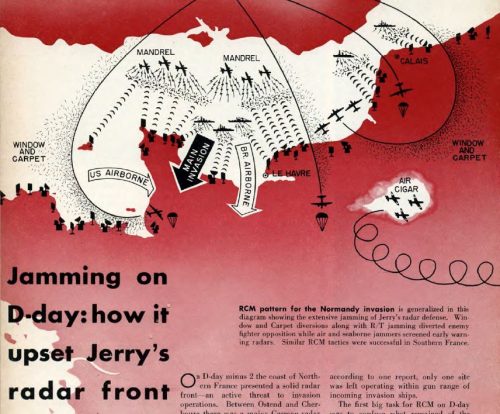
RETRO-HIGH TECH BACKGROUND
World War 2’s “Retro-High Tech” warfare was defined on the ground, in the air and on the sea by the use of electronic signals intelligence (SIGINT) with the addition of RADAR for land or sea based airpower. Both SIGINT and RADAR had to be tied together to an effective radio and wire telecommunications network in order to provide both intelligence services the necessary data for evaluation and the military commanders the processed intelligence to act upon in order to be effective.
The effective use of RADAR required a very rapid gathering, processing, decision making and dissemination of those decisions over a vast geographic area by radio, telegraph and telephone. During World War 2 (WW2) RADAR networks had the addition of first radio direction finding and then “low level” signals intercepts of voice and Morse code in the clear, simple, easy to use, but quickly breakable codes — Organizations doing this were called “Y-Service” by the British — followed eventually by higher level cryptographic code breaking (or “ULTRA”) being added into this network.
This four legged stool of military sensors, communications, intelligence, and decision making by military commanders is normally referred to as Command, Control, Communications and Intelligence or “C3I”. In particular, RADAR played the role of “Keystone Military Technology.” And by “Keystone” I mean an analogy to the biological concept of a “Keystone species” in an ecosystem, not unlike the role of algae in the ocean ecosystem or grass for a prairie ecosystem. This military C3I ecosystem model is far more developed in the 21st century especially with the arrival of digital electronic computers — but it is simply a conceptual embellishment of this 1940’s “Revolution in Military Affairs.”
RETRO-HIGH TECH LIMITATIONS
The fundamental problem Normandy campaign was the Western Allied powers were going to put more aircraft and ships into their respective air and sea space than could be effectively controlled by the available C3I systems. The quartz crystal control VHF (think television channels 1 thru 13) radios and the meter band radars did not provide enough bandwidth for communications nor precise target definition and altitude for tight two way radio directive control of fighter patrols or surface ship screens. In the age before computer spread sheets and data bases the Western Allied had to control all the emissions for thousands of radios and radars as well as plan on how all these ships and planes were going to shoot move and communicate together without enough electromagnetic spectrum to do so.
To give you an idea as to the scale of the issue, the primary VHF fighter radio for the Allied air forces in the United Kingdom was the SCR-522 or a British radio that the SCR-522 was copied from. (The scale of the USAAF and Lend Lease production was such that American build SCR-522 was the predominant fighter radio in the Normandy invasion.) It was four channel, amplitude modulated (AM), push button, quartz crystal frequency controlled radio that transmitted between 100 Mhz and 156 Mhz. A typical US Army Air Force WW2 fighter squadron set it’s SCR-522 as follows:
Channel A is the frequencies for all planes;
Channel B is the squadron command frequency;
Channel C is the D/F* homing frequency;
Channel D is the D/F* fix frequency”
.
*D/F means direction finding
There were going to be _171_ Allied fighter squadrons in Operation Neptune. Now see the following passage
from page 8 of USAF historian Richard P. Hallion’s 1994 history “D-Day 1944: Air Power Over the Normandy Beaches and Beyond.”
Air Support on the Beaches
During the June 6 D-Day assault itself, a total of 171 squadrons of British and AAF fighters undertook a variety of tasks in support of the invasion. Fifteen squadrons provided shippingcover, fifty-four provided beach cover, thirty-three undertook bomber escort and offensive fighter sweept thirty-three struck at targets inland from the landing area, and thirty-six provided direct air support to invading forces. The Luftwaffe’s appearance was so minuscule that Allied counterair measures against the few German aircraft that did appear are not worth mentioning.
To give each of those 171 squadrons the standard four frequencies operationally required would call for 564 separate radio channels. Worse, each squadron was between 12 (RAF) and 16 (USAAF) fighters. So you would be looking at between 2052 and 2736 transmitters on those frequencies. If you think digital WiFi congestion of 50 lap tops and tablets at your local Starbucks is bad. That’s nothing compared to the physical impossibility of putting 564 analog radio channels, with ~2300 transmitters, between American broadcast television channel’s 6 and 7.
OPERATION NEPTUNE’S PLANNING AND AGNER ERLANG’S HIGH MATH
In an operation as large as Operation Neptune, planning had to start early. It had to be comprehensive. And it had to include every possible contingency. In modern military terms, it needed a “GO.T.H.” plan built in . [AKA, what you would do when everything else GOes To Hell.] This detailed planning kicked off in January 1944. See Figure 2 below.
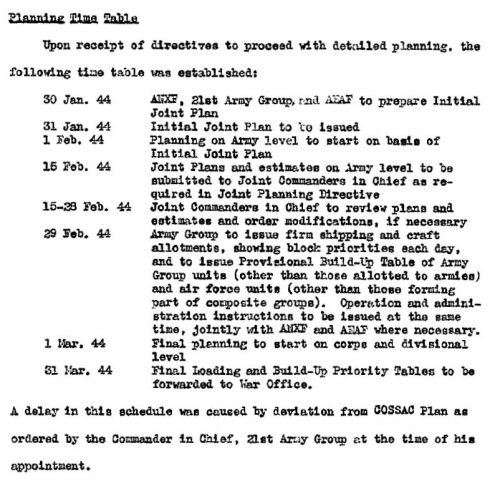
This detailed planning included the following issues to be addressed based on the operational experiences of the Operations Torch, Husky, Baytown, Avalanche and Shingle. This list included the following:

This planning process was heavily disrupted, especially in terms of signals and frequency allocation when General Bernard Montgomery took over invasion planning of 21st Army Group and added additional infantry divisions to the initial assault forces. To deal with this change a series of boards, committees and sub-committees were created to deal with the new invasion plan. See figures four and five below for a partial list.
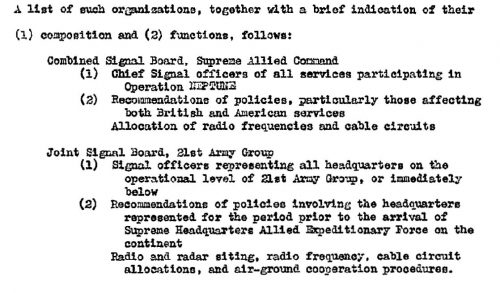

It was the Mutual Interference Sub Committee, Combined Signal Board, Supreme Allied Command that drove the signals plans for Normandy. It did this via a series of practical exercises to determine primary, 2nd and 3rd order harmonic interference patterns for every piece of radar and radio gear in the invasion with priorities on which system gets the best terrain features. See item two in figure six below.
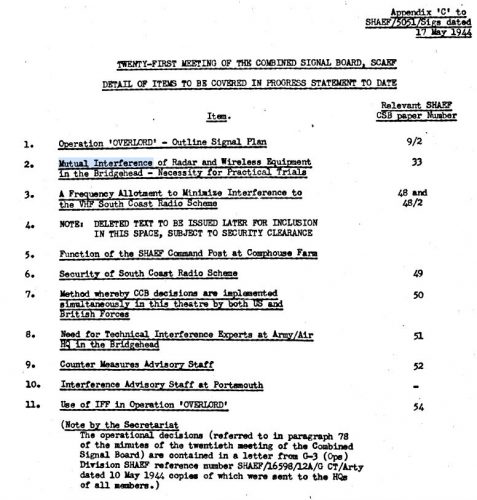
This in turn caused a large number of mathematicians in uniform to start determining frequency allocation via working with a then 26 year old mathematical formulas governing telephone call traffic engineering and queueing theory invented by a Danish telephone engineer by the name of Agner Krarup Erlang. In 1917 Erlang published “Solution of Some Problems in the Theory of Probabilities of Significance in Automatic Telephone Exchanges“, which contained formulas for loss and waiting time, which are now well known in the theory of telephone traffic. Originally published in his native Danish, Erlang’s work was rapidly translated and published in English in the Post Office Electrical Engineers Journal Volume 10 (19171918) Pages 189197. The mathematicians were generally in the uniforms of the RAF and US Army Signal Corps as the pre-war telephone engineering necessary to create Fighter Command and the continent sized American telephone system, respectively, left them with the most practical experts with the Erlang formulas.
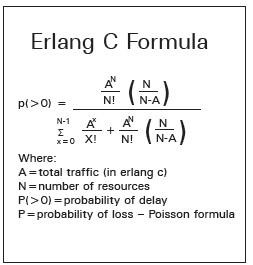
What these mathematicians in uniform were doing is known today as Frequency Deconfliction**. It was accomplished in the spring of 1944 with ledger books, lots of skull sweat and endless meetings where officers with stars in a rainbow of different service uniforms often shattered many days or weeks of calculations due to rearrangements of who owned which piece of the radio spectrum.
[** A systematic management procedure to coordinate the use of the electromagnetic spectrum for operations, communications, and intelligence functions. Frequency deconfliction is one element of electromagnetic spectrum management. See also electromagnetic spectrum; electromagnetic spectrum management; electronic warfare. (JP 3-51) (US DoD)]
HOW ALLIED PLANES GOT THEIR INVASION STRIPES
It was in the last of the major meetings of the Combined Signal Board (See item 11 in Figure 6 above) that it was concluded that the thousands of aircraft involved in the invasion would saturate and break down the Allied Mark III IFF (Identification Friend or Foe) system. [Note: The Mark III IFF shared the same frequencies covered by the SCR-522!] This same meeting also approved an alternate visual identification system to replace it – Invasion Stripes.
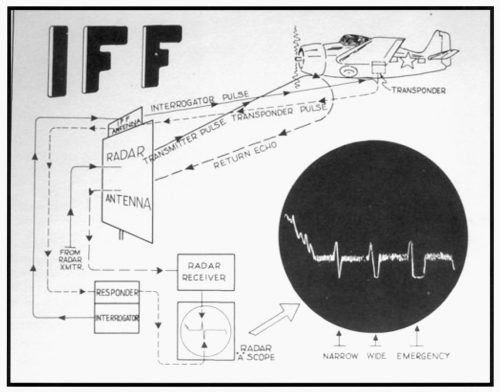
This visual identification system was pure RAF in origin and it came from bad experience. Namely, it turned out that both the Hawker Typhoon and early production Hawker Tempest Mark Vs had very similar short noses and wing taper to German FW190’s when seem from above and below. Both planes were taking fire from other RAF fighters — mainly Fighter Command Spitfire V’s — intended for the Focke-Wulf Fw 190. Identification bands were added by the RAF to aid identification of these planes in combat. According to the Wikipedia article on the subject:
The order was promulgated on 5 December 1942. At first they were applied by unit ground crews, but they were soon being painted on at the factory. Four 12-inch-wide (300 mm) black stripes separated by three 24-inch (610 mm) white, underwing from the wingroots. From early 1943 the Typhoons also had a yellow, 18-inch-wide (460 mm) stripe on each of the upper wings, centred on the inner cannon. All of these markings were officially abandoned 7 February 1944.

When Air Chief Marshal Sir Trafford Leigh-Mallory, commanding the Allied Expeditionary Air Force approved the invasion stripe scheme. It wasn’t simply a negative control “don’t shoot me” measure. The Allies were reverting to a Western Front WW1 aerial tactic. They were doing standing fighter patrols.
The RAF used standing fighter patrols not only on the WW1 Western front, but also in the Western Desert through 1942, until they had enough radars and VHF band radios to actively control their fighter-interceptors. In the interim period of 1940-1941, the RAF augmented these standing patrols with broadcast plots of German air movements using radar and Y-service intercepts of German Luftwaffe signals so pilots could use the information and their initiative to deal with German raids. This was the same sort of running commentary fighter control system that German night fighters later adopted to deal with RAF Bomber Command jamming limited Luftwaffe radio bandwidth over Germany in 1943.
This standing patrol plus running commentary fighter control system allowed upwards of 7,000 aircraft sorties flying over the Normandy area the day of the invasion and close to 10,000 sorties when the wider RAF operations over France, the English Channel, North Sea and Bay of Biscayne by RAF Coastal Command, RAF Bomber Command, RAF Fighter Command and Allied Expeditionary Air Forces (AEAF) are taken into account.
Words cannot do justice to the numbers and scale of this air effort, so see the following maps:

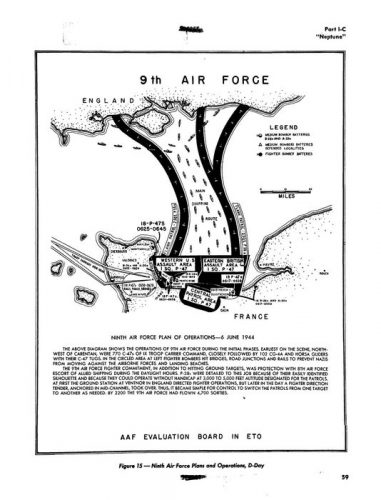
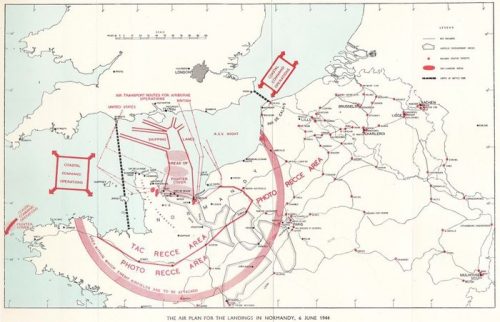
BOMBER COMMAND’S “SHOCK AND AWE” & FIGHTER COMMAND’S SEAD CAMPAIGN
In May 1944 the Allies, and particularly the RAF Bomber Command’s 100 Group, had the measure and more than the measure of the “murder’s row” of German air defense radars thank to a lot of hard work by Allied Ultra code breaking signals intelligence and the radar intercept operators flying in the planes of RAF 100 Group.
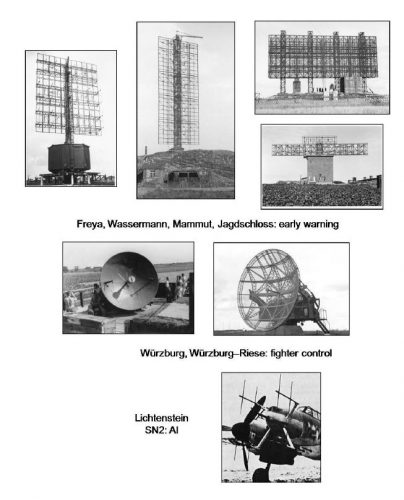
However, while the RAF’s “Window” radar decoys, radar & radio jammers had the measure of German Luftnachrichten Dienat’s (Air Surveillance Service) land based radars. The Germans were passively tracking Bomber Command radio, radar, and yes jamming signals with a separate passive electronic signal tracking organization called the Funkaufklärungsdienst. The Luftwaffe Funkaufklärungsdienst was once part Luftnachrichten Dienat organization and separated from it the year before Normandy. It the used a network of passive ground sensors for direction finding to place night-fighters into the stream of RAF 4-engine bombers. Where the Lichtenstein FuG 220 (Model SN-2) Air Intercept (A.I.) radar — immune to RAF dropped aerial decoys and jamming — let the night-fighters kill bombers at will.
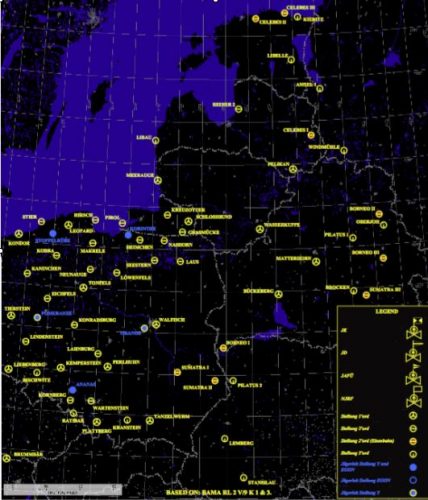
It would not be until July 1944 and the capture of this wrong-way German Ju-88 night-fighter that the secrets of not only the German A.I. radar, but also many of the ways the Funkaufklärungsdienst was passively tracking Bomber Command became known, as smaller versions of the bomber tracking passive sensors were also on the night-fighter. The electronic measure/counter-measure situation was as seen below in Figure 15.
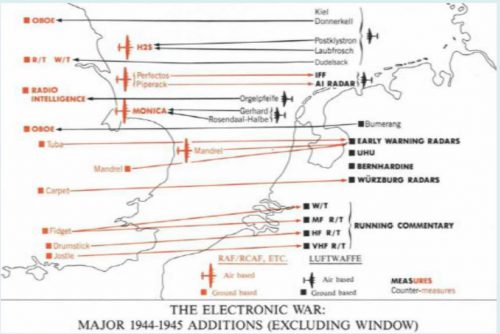
The FuSAn 724/725 “Bernhard/Bernhardine” transmitted in the 30 – 33.3 Mhz VHF radio band below today’s VHF television channel 2. It was was high powered, directional and it’s antenna rotated twice a minute. It was the key communications link between both the ground based Luftnachrichten Dienat & the Funkaufklärungsdienst and the Luftwaffe night-fighter force in the air. Luftwaffe radar/radio operators in the night-fighters could switch between 2 FuSAn 724/725 stations and obtain both a fix and text message air battle update every minute. It also meant they did not have to work two radios to find a jamming free frequency! This set of characteristics very made them extremely difficult to jam as a number of Allied airborne jammers had to orbit the antenna between it and any German night fighters in its up to 400km range. There simply were not enough jammers for the FuSAn 724/725 in France and to cover all the other tasks planned on D-Day. See Figure 1 at the beginning of the article.
The combination of the unsuppressed Funkaufklärungsdienst passive sensor network and the “Bernhard/Bernhardine” night-fighter beacons in France represented a horrible threat to one of the key phases of the Overlord landings. The night time parachute drops of the American 82nd and 101st Airborne divisions and the British 6th Airborne division. The unarmored, slow and heavily laden C-47’s and glider towing British bombers simply were meat on the table for Luftwaffe night-fighters. See Figure 14. below:

To deal with the Luftwaffe night-fighter threat to the airborne drops, three weeks before D-Day the RAF Fighter Command and the AEAF began a systematic campaign to attack German radars in France. It was the first comprehensive Suppression of Enemy Air Defenses (SEAD) campaign in military history. Thanks to the foresight of R.V. Jones, the head of at RAF Scientific Air Intelligence, there was a catalog, complete with photos and map locations, of all German radar installations in Western Europe. And thanks to the assistance of the Air Ministry’s Telecommunications Research Establishment (TRE), the Fighter Command had a special radar hunting kit called ABDULLAH fitted to Hawker Typhoon fighters to assist in the campaign. Unfortunately, as the Greg Goebel’s “Electronics Warfare Against The Axis” web site describes below, sometimes “good ideas” are not practical tools in the face of a competent enemy.
Three weeks before the invasion, Allied bombers and strike aircraft began to attack critical radar stations. Rocket-firing RAF Hawker Typhoon strike fighters proved most effective, but encountered heavy anti-aircraft defenses. The TRE fitted a few Typhoons with a device named “Abdullah” that could home in on radar sites; it was the ancestor of the modern “radar homing and warning (RHAW)” receiver used on “Wild Weasel” type defense suppression aircraft. Abdullah worked fine, but it proved to have a serious drawback. German radar sites that observed Allied aircraft flying straight down the boresight at them immediately put their flak defenses on full alert, and the effect of Abdullah was to simply make the attacks harder. It was set aside, and attack plans were modified so that the Typhoons flew an oblique course toward a radar site and only turned directly on it at the last moment. A better approach to “defense suppression” would need to wait for a later conflict.
R.V. Jones memoir MOST SECRET WAR: British Scientific Intelligence 1939-1945 in his D-Day chapter (43) discusses the AEAF/Fighter Command SEAD effort and what it took to get his radar catalog included in the effort. On page 408 he discusses how well the attacks on German radars went. This is where the “and it went happily ever after” effect of most wartime memoirs comes in. The 12 May 1945 RAF report “REPORT ON AIR OPERATIONS PRIOR TO AND IN SUPPORT OF OPERATION “NEPTUNE” paints a very different story of how things really went.
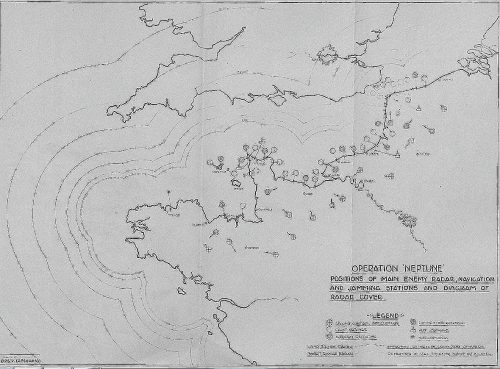
While R.V. Jones radar catalog humbugged the need to use the radar homing abilities of ABDULLAH. Since the RAF fighter squadrons didn’t need to home on radars they knew the locations of anyway. The straight into them tactic developed with ABDULLAH and the huge German flak response it generated slowed the destruction of German radars to a crawl. The AEAF leaders of the SEAD campaign had to stop and reassess priorities for the final three days before D-Day. See paragraphs 111, 112, & 113 of “REPORT ON AIR OPERATIONS PRIOR TO AND IN SUPPORT OF OPERATION “NEPTUNE” below:
111. On 10th May, 1944, a series of attacks was commenced against the long range aircraft reporting stations and on 13th May, attacks were commenced on the installations used for night fighter control and the control of coastal guns. On 25th May, 42 sites were scheduled for attack. These sites included 106 installations; at D-3, fourteen of these installations were confirmed destroyed.
.
112. To conserve effort, it was then decided, three days before D-day, to list the twelve most important sites, six chosen by the Naval authorities and six by the air authorities. These twelve sites, containing thirty-nine installations were all attacked in the three days prior to D-day.
.
113. Up to D-day, 1,668 sorties were flown by aircraft of A.E.A.F. in attacks on Radar installations. Typhoons in low level attacks flew 694 sorties and fired 4,517 x 60-lb. rocket projectiles. Typhoons and Spitfires made 759 dive bombing sorties, dropping 1,258 x 500-lb. bombs, and light and medium bombers dropped 218 tons of bombs. In addition, the sites and equipment were sprayed with many thousands of rounds of cannon and machine gun fire.
In addition to the 12 AEAF targets, more four German military radio transmitting C3I facilities were struck with maximum short range bomb load OBOE radio navigation strikes of 70 to 120(+) RAF Bomber Command Lancaster bombers each with 450 to 600 tons of bomb per target. At an average of 5.75 tons of bombs per Lancaster, these attacks amounted to OBOE ARC LIGHTS**.
[**ARC LIGHT refers to the 1965 to 1973 era use of three plane B-52 formations to drop bombs bombs in the Republic of South Vietnam in support of ground troops. Typical bomb loads were 20 to 27 tons of bombs per B-52.]
Of the sixteen AEAF/Bomber Command C3I targets, eight were absolutely vital to the success of the Overlord landings. The first two were the Luftwaffe “Bernhard/Bernhardine”night-fighter radio navigation beacons covering northern France. One was destroyed and one inoperative on D-Day after RAF attacks.
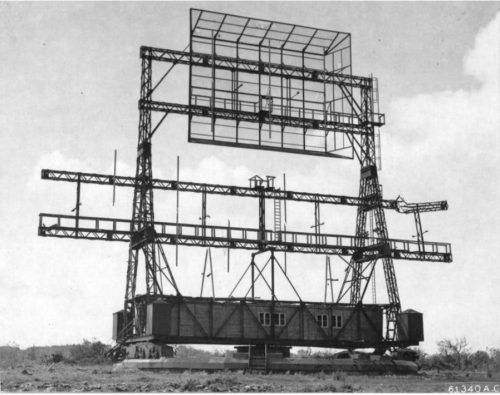
Targets four through six were radio transmitters struck by Bomber Command. Identified by their unique teletype cipher transmissions, three Geheimschreiber (secret writer) sites from France to the Oberkommando der Wehrmacht (German High Command, OKW) in Berlin were flattened.
This fact was -NOT- in the 12 May 1945 RAF report. It is something I deduced from many other readings and especially watching the following video from the Military History Visualized You Tube channel. This video explains what the German OKW knew and when did they know it on the Normandy landings. When you compare radio sites the Bomber Command struck and the gaps the MHV channel described. They fit hand and glove. See:
On D-Day what did the Germans know?
Military History Visualized
Published on May 28, 2019
https://youtu.be/z3UHrnTUgZE?t=109
Target seven reflected not only the need to protect airborne troops, but also some measure of Bomber Command’s desire for payback for the debacle that was the failed Berlin bombing campaign. The last Bomber Command C3I target was the Funkaufklärungsdienst’s Cherbourg/Urville-Hague headquarters in North Western France. This is how the 12 May 1945 RAF report “REPORT ON AIR OPERATIONS PRIOR TO AND IN SUPPORT OF OPERATION “NEPTUNE” described the attack:
Cherbourg/Urville-Hague. This station is now known to have been the headquarters of the Nazi “Y” Service in North Western France. The attack on this important W/T centre was made on 3rd/ 4th June by 99 aircraft, dropping 570 tons of bombs. The results were remarkable, the centre of a very neat bomb pattern coinciding almost exactly with the centre of the target area. The photographic interpretation report may be quoted verbatim :-
.
“(a) The station consisted of a line of W/T masts running diagonally across an old fort, and the Headquarters buildings, 150 yards to the south.
.
(b) Both the masts and the buildings have been demolished; all have received many direct hits. The outline of the only two large blast-wall protected buildings is only just discernible among the craters and the debris.
.
(c) The target is at the centre of a well-defined concentration of many hundreds of craters. ” The station is completely useless. The site itself is rendered unsuitable for rebuilding the installation, without much effort being expended in levelling and filling-in the craters.”
.
126. The success of this attack on the German Air Force “Y” Headquarters must have been a major catastrophe for German Intelligence and it may well be that it was an important contributory factor to the lack of enemy air reaction to the assault.
The text in paragraph 126 above was the RAF bragging without giving away the “ULTRA Secret,” because the RAF was very much aware that it had done just that — inflict a catastrophic intelligence disaster — upon the Luftwaffe.
Target eight was the apparent German Wassermann radar complex at Tausenfussler near Cherbourg-Octeville on the tip of the Cotentin Peninsula. And I say apparent for a reason, because the so-called Wassermann was anything but. It was a Luftwaffe technological surprise that was strategic in scope. It was a new radar, in a network of six, that was impossible for the Allied to jam without leaving Great Britain defenseless, because it was a bi-static radar that used the transmission of Fighter Command’s own Chain Home radar chain! It was a Klein Heidelberg a WW2 bistatic radar system that was decades ahead of its time.
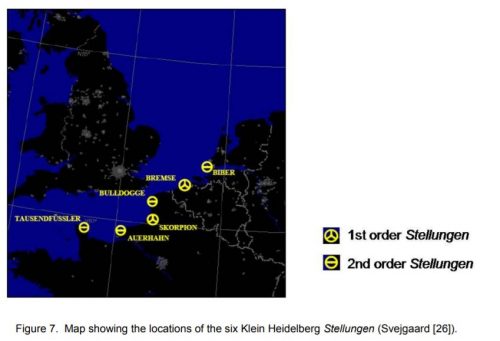
LADY LUCK FAVORS A PREPARED RAF
It cannot be overstated what a stroke of luck befell the RAF in striking the apparent Wassermann at the Tausenfussler location. Had it been operational the night of 5/6 June 1944. The results would have been horrific, as there were 24 available Luftwaffe night fighters that were decoyed by RAF jamming and window well to the east of the Cotentin Peninsula. See Figures 1 above & 20 below.
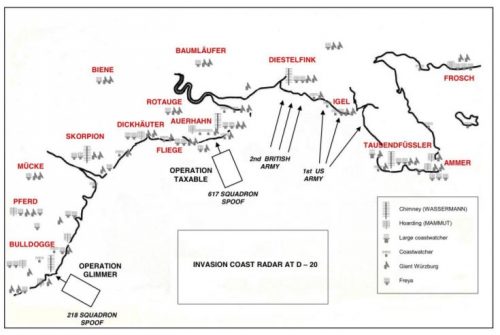
This is how paragraph 127 of “REPORT ON AIR OPERATIONS PRIOR TO AND IN SUPPORT OF OPERATION “NEPTUNE” described the affect of this decoy operation on the Luftwaffe night-fighter force.
127. On the night of 5/6th June in the opening phases of the assault, the counter measures against such installations as were still active were put into operation. In connection with a diversionary naval force, a formation of specially equipped aircraft flew up and down the coast from Dieppe to the mouth of’ the Somme. The energy was apparently led to believe this to be a major bomber formation, as he reacted with twenty-four fighters which were active approximately three hours hunting the ghost , bomber stream.
Had the Tausenfussler Klein Heidelberg been operational, it’s borrowed Chain Home 50 m wavelength (around 6 MHz) radar signal was so different from the jamming and 1.5 meter wavelength tuned window used in TAXABLE, GLIMMER, plus the bomber stream spoof, that it would have seen right through them. The slow speed of the troop carrier streams compared to RAF Lancaster’s would have betrayed their identity and brought Luftwaffe night-fighters like a school of sharks. Leading German night-fighter pilots could get two to five Lancaster bombers in a single sortie. The slower, unarmored and unarmed transports, many towing gliders, would be easy meat even for novice night-fighter pilots. Easily 50 or more of the 840 IX Troop Carrier Command C-47 could have fallen to the guns of the 24 decoyed Luftwaffe night-fighters. At 24 souls per loaded C-47 or 35 per tow plane plus towed glider, between 1200 and 1750 paratroopers and air crew would have died but for the RAF’s SEAD attack.
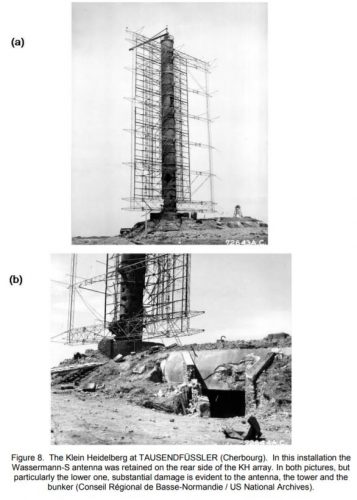
And the destruction was not the only stroke of luck the RAF had in it’s last three days of strikes on the German C3I system. The destruction of the Funkaufklärungsdienst’s Cherbourg/Urville-Hague headquarters in North Western France had an additional dividend. As the 10,000 Allied planes across Britain were preparing for D-Day, they were all testing their Mark III IFF systems. The Funkaufklärungsdienst’s intercept operators were listening.
While they Mark III were not to be used over Normandy proper. The systems absolutely were to be used entering RAF Fighter Command controlled air space. As Fighter Command had a very sanguinary reputation of shooting first and only grudgingly answering awkward questions about missing allied air crews when wreckage was found. Every Allied air crew checked their Mark III IFF repeatedly before take off. And as each plane squawked electronic signals, nearby planes squawked replies and so on and so forth. As can be imagined, this raised an incredible electronic racket that could be and was picked up by Funkaufklärungsdienst intercept operators. It was picked up, reported…and not believed.
The following is from ROYAL AIR FORCE HISTORICAL SOCIETY JOURNAL 28, Royal Air Force Historical Society, First published in the UK in 2003 by the Royal Air Force Historical Society.
MORNING DISCUSSION PERIOD
.
Page 52
.
Peter Hearne. I was struck by a comparison between a point raised in Mr Streetly’s paper and a chapter in R V Jones’ book, Most Secret War, regarding the vulnerability of Bomber Command’s aircraft to German night fighters homing on their transmissions. This would possibly have involved IFF and the problem was certainly present in the context of H2S and MONICA. Jones recalls that he had a conversation with a German scientist who said that they were very surprised at how lax Bomber Command’s discipline was, or perhaps how unguarded they were; either way, it seems that the Germans were certainly planning to exploit this weakness.
.
I wondered whether there was any sort of read-across between our own night fighter’s use of SERRATE and PERFECTOS and our related efforts to protect Bomber Command’s aircraft. In that connection someone has written, (it may have been Dr Price) that the one person who correctly predicted that D-Day was about to happen, was a German radio operator on the listening watch in Holland who detected an enormous amount of tuning pulses from RAF aircraft on the night of 5 June and deduced that the invasion might take place on the following day. Happily, his message was disregarded.
The mass death inflicted on the Funkaufklärungsdienst leadership in France left no one with the technical training and seniority to make the right call with the right information.
If “Luck” is defined as “Opportunity Meeting the Prepared Mind” then the R.V. Jones Air Ministry catalog and the AEAF’s SEAD campaign made the luck of the paratroopers of the 6th, 82nd, 101’s airborne Divisions at Normandy.
PROTECTING THE INVASION FLEET & THE ARRIVAL OF THE RAF’S RADAR SHIELD IN FRANCE
The real C3I issue for the invasion fleet was how to practically see and control the land based airpower protecting it and directing it’s use over the beach head. The Normandy Coast of France was too far away for the land based radar network of Britain to be of practical use. The Allied invasion fleet had to bring it’s own radar, radio and radio intercept capabilities for fighter direction with it. And it had to command naval, air and ground forces simultaneously. And executing those C3I roles is where the centralized command, combined nationality and joint service amphibious warfare culture of the Western Allies in Europe was radically different that the US Navy/US Marine Corps amphibious culture of the Pacific. The UK Royal Navy’s armored carriers simply did not have the internal space for a US Navy style fighter direction system. And even if they did, it was still not anywhere near enough space to control the high hundreds hundreds to high thousands of land based planes the Allies in Western Europe routinely brought to bear from 1943 onward.
There was simply no real way to have a US Navy style AGC amphibious command ship could do both the jobs of fighter direction and landing force high level command. This was due to both frequency bandwidth/interference issues on the AGC and because when this was attempted with the USS Ancon (AGC-4) at the Salerno landings. Luftwaffe signal intelligence used direction finding to isolate it’s location and dispatch specialized anti-ship squadrons to attempt to sink it!
This lesson caused the Allies to separate their defensive air superiority C3I platforms from the Landing force and offensive air power C3I platforms. The defensive role was taken over by a joint RAF/Royal navy ship called a Fighter Director Tender (FDT). These ships were converted landing ship tank (LST) with a full RAF land based fighter sector control center and a 1.5 meter/200 Mhz altitude determining Ground Control Intercept (GCI) radar and a full suite of radio and radar beacons for work with and control of night fighters. There were three of these FDT ship used in Normandy.
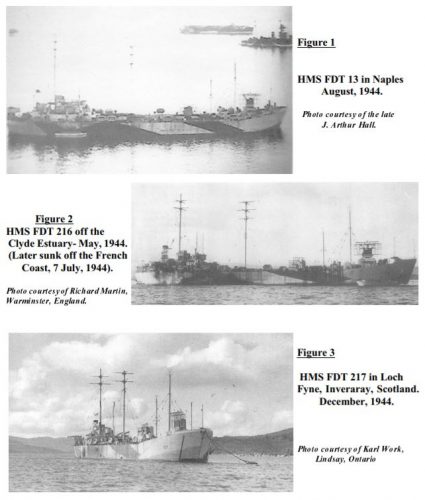

The three FDT were equipped with a full RAF Fighter Sector radio and command center set up, two GCI radars plus a suite of meter and microwave band radar beacons. The reason for two GCI radars was simple. The Germans had jammed the 1.5 meter band GCI radars the FDT carried at Anzio in support of Luftwaffe radio guided missile strikes on the Allied fleet there. The second GCI radar on the FDT’s operated on the same 50 Cm frequency of the German Wurtzburg and Wurtzburg-Riese of German air defenses. So if the primary GCI radars’s on the FDT’s were jammed. They would switch to the 50cm sets. This was a less advanced version of the “Hug the enemy’s radio spectrum” game that the Luftwaffe played with the Klein Heidelberg. Come the event, the FDT’s 50cm GCI radar sets were not needed.
The German military leaders who would have made the decision to jam the 1.5 meter band FDT radar sets in Normandy were dead under a dense set of bomb craters at the Funkaufklärungsdienst Cherbourg/Urville-Hague headquarters in North Western France.
ALLIED NIGHT FIGHTER COVERAGE AT NORMANDY
The first night after the landings saw the pay off from the FDT’s. Their extra fighter direction command and control facilities — compared to the US Navy AGC in the Pacific — allowed a dense coverage of 38 twin engine and multiple crew Mosquito and P-61 Black Widow night-fighters over Normandy in June 1944. The radar beacons on the FDT allowed the night-fighters know if they were in the correct orbit locations via their radars “pinging” them without a lot of radio communications. This is compared to only six night fighter orbits at Okinawa by the US Navy during May-June 1945. And, unlike the single engine Hellcat and Corsair night-fighters of the Pacific War. These twin engine night-fighters not only carried the heavy but immensely better SCR-720 A.I. radars to go with their IFF. They had the raw engine power and room to carried their own radar beacons for the FDT to inspect out to the radar horizon without setting off IFF. This “out to the horizon” radar tracking range plus the provision for RAF Y-Service signals intercept teams specializing in direction finding upon and real time translating of Luftwaffe fighter radio traffic on the FDT gave Allied night-fighter a reach across Northern France. See figure 24 below.
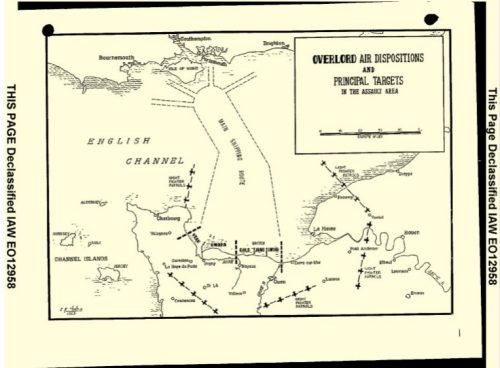
It was a good thing that the FDT’s performed so well because Allied plans to project it’s “Ground Radar Shield” upon French shores nearly failed at Omaha Beach.
RAF GROUND RADAR CONVOY PLANS AND THE REALTY OF OMAHA BEACH.
There were extensive plans for the rapid build up of RAF radars very early in the Normandy landings for several reasons. The RAF was simply better at controlling night-fighters. Their radar operators had more combat experience. And they had simply put more thought into how to configure radars on vehicles and move them across a beach. This was reflected in the engineer planning for Neptune with RAF 85 Group GCI.
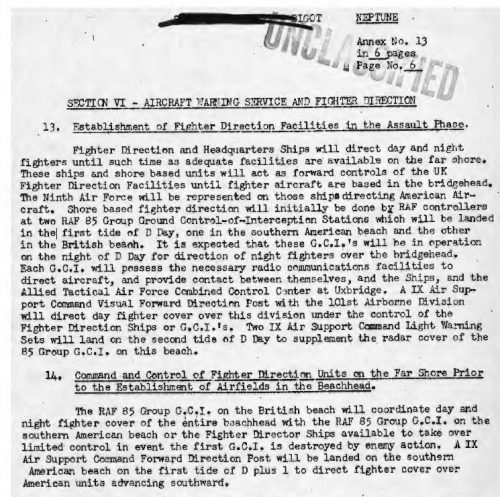
The reality was when RAF Ground Convoy 15082 landed at the second tide on Omaha Beach. German artillery observers of the 352nd Infantry Division still had commanding sight lines on the beaches with wire communications to heavy artillery. And radars were priority artillery targets. The result was as destructive as it was quick and bloody.
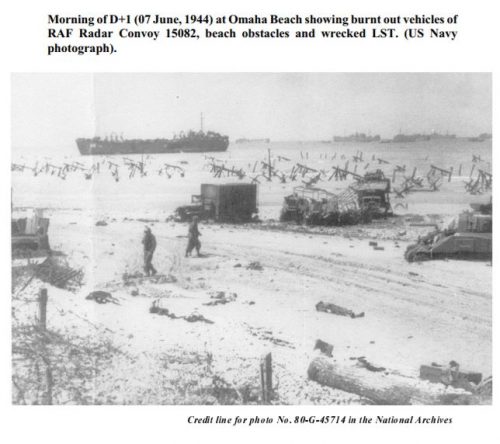
Despite the bloody set back for RAF Ground Convoy 15082 at Omaha Beach, the graft of RAF radar deployments on the French coast took hold. And the following RAF radar units were landed upon the far shore.
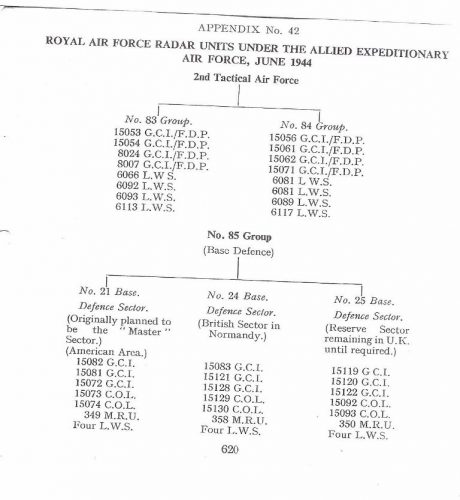
AFTER D-DAY — THE U.S. NINTH AIR FORCE COMES INTO ITS OWN
Thus far the C3I story of Normandy has been a British one. This is because, frankly, in all things radar and signals intelligence, British forces had a four year head start. But in that time, there was one USAAF general who learned this new C3I trade from his RAF tutors in North Africa, Sicily and Italy. And on the far Normandy shore, he exceeded the best that his tutors taught him. He was General Elwood Richard Quesada, CB, CBE , he commanded the Ninth Air Force’s IXth Fighter Command. From that post, in Operation Neptune planning, General Quesada was the American flag rank expert in projecting land based air-power through an amphibious fleet to a far shore. And where he exceeded his British tutors was in using radar and radio as an offensive tool to place tactical air-power where ground forces needed them on that far shore.
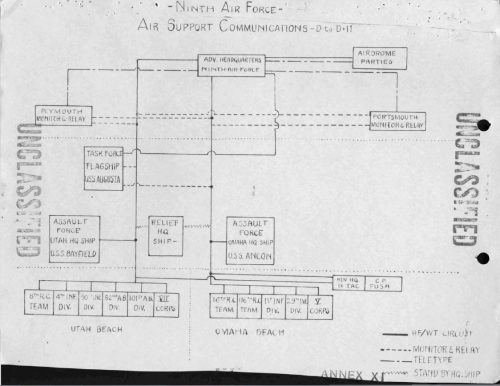
The key element of IXth Fighter Command was Quesada’s baby, the IXth Tactical Air Command. It was a unique organization that combined all the best technique of RAF C3I with the best of the then brand new American 10cm microwave radars. The keys were the huge Microwave Early Warning radar (MEW) hand built by the British Branch of the MIT Radiation Laboratory in Britain (Later given the Army-Navy designation AN/CPS-1) and the SCR 584 microwave gunfire radars that helped save Anzio from the Luftwaffe, because it’s 10cm wavelength was immune to German meter band jamming and Window decoys. The MEW could control a huge amount of airspace and it’s displays were better than anything the RAF had ever seen. While the SCR-584 could lock on to a target in three dimension and generate fire control solutions that could place anti-aircraft artillery shells within a few dozen feet of a target. Networked together with signals intelligence detachment from the 3rd Radio Squadron Mobile (RSM), it was an air superiority C3I system without match.
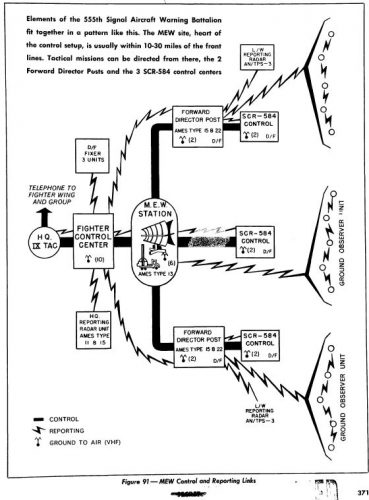
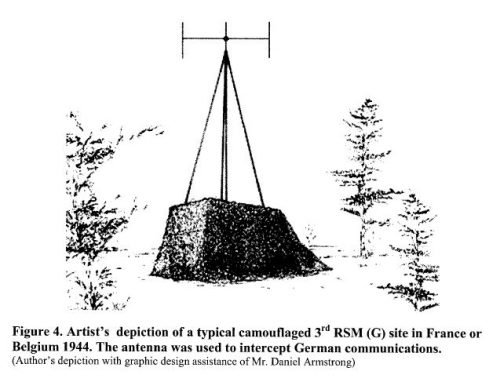
It was Quesada’s IXth TAC that saw off the Luftwaffe’s fighter counter attacks in June 1944. Per Martin Bowman’s Osprey book “P-47 THUNDERBOLT VS BF109G/K Europe 1943-45,” at pages pages 39 and 40, there were two mixed BG109/FW190 Luftwaffe fighter Gruppen, JGs 2 and 26, in Normandy. Between them they had 425 BF109 and FW-190 fighters, of which only 250-280 were operational at any one time in the spring of 1944.
In the time immediately after the Normandy landings, the Germans put in 15 more Jagdgruppen into France by June 9, 1944…and lost 170 pilots killed in action plus lost another 350 planes destroyed or damaged on the ground by the time they withdrew at the end of June 1944.
CLOSING OUT THE C3I SECRETS OF D-DAY
It took six years of combat experience and fevered development, five months of intense planning, and seven weeks of intense execution for the air, sea and land based C3I systems of the Normandy of the Allies to make the leap across the English Channel to first wrest first electromagnetic and then aerial supremacy from the Luftwaffe. And now on it’s 75th anniversary, these “C3I Secrets” have finally been told.
-End-
SOURCES AND NOTES:
ARMY AIR FORCES HISTORICAL STUDIES: No.36 NINTH AIR FORCE APRIL TO NOVEMBER 1944 AAF HISTORICAL OFFICE · HEADQUARTERS, ARMY AIR FORCES Prepared Historical Office Headquarters Army Air Forces October 1945
Steve Blank’s “Hidden in Plain Sight: The Secret History of Silicon Valley” http://steveblank.com/secret-history
Martin Bowman “P-47 THUNDERBOLT VS BF109G/K Europe 1943-45. Osprey Publishing; 1st edition (August 19, 2008) ISBN-10: 1846033152, ISBN-13: 978-1846033155
https://www.amazon.com/P-47-Thunderbolt-Bf-109G-1943-45/dp/1846033152
F. Dörenberg, BERNHARD INSTALLATION BE-4 AT LA PERNELLE (France, dept. 50) https://www.nonstopsystems.com/radio/hellschreiber-bernhard-Be4.htm
Effectiveness of Third Phase Tactical Air Operations in the European Theater, 5 May 1944 — 8 May 1945
http://cgsc.contentdm.oclc.org/cdm/ref/collection/p4013coll8/id/1380
Erlang Calculation An Introduction
https://www.callcentrehelper.com/an-introduction-to-erlang-calculations-79806.htm
Agner Erlang and the Mathematics of Telecommunication Traffic
http://scihi.org/agner-erlang-telecommunication-traffic/
Greg Goebel [9.3] GLIMMER & TAXABLE / OPERATION POST MORTEM
http://craymond.no-ip.info/awk/ttwiz9.html
Hugh Griffiths and Nicholas Willis “Klein Heidelberg a WW2 bistatic radar system that was decades ahead of its time” Expanded on-line version of a paper published in IEEE Transactions on Aerospace and Electronic Systems
https://www.researchgate.net/publication/229030676_Klein_Heidelberg-a_WW2_bistatic_radar_system_that_was_decades_ahead_of_its_time
Richard P. Hallion’s “D-Day 1944: Air Power Over the Normandy Beaches and Beyond.” Air Force History and Museums Program 1994 Air Force History Support Office, 3 Brookley Avenue Box 94, Bolling AFB DC 20032-5000
https://apps.dtic.mil/dtic/tr/fulltext/u2/a432943.pd
Horace R. (Red) Macaulay, Chapter XI GROUND CONTROLLED INTERCEPTION RADARS IN OPERATION NEPTUNE/OVERLORD, “THE ALLIED INVASION OF FRANCE” JUNE, 1944. The story of the Fighter Direction Tenders used during the “D-Day” Assault and The Mobile Radar Convoys that Landed on the Beaches. RCAF Radar History at the “The Canadian Radar History Project” web site. www.rquirk.com/cdnradar/cor/chapter11.pdf
Thomas Alexander Hughes, Overlord: General Pete Quesada and the Triumph of Tactical Air Power in World War II, Free Press, October 3, 2002 ISBN-10: 0743247833 ISBN-13: 978-0743247832
https://www.amazon.com/Overlord-General-Quesada-Triumph-Tactical/dp/0743247833
Invasion stripes
https://en.wikipedia.org/wiki/Invasion_stripes
John F. Kreis, Air Warfare and Air Base Air Defense 1914-1973 Office of Air Force History United States Air Force Washington. D. C. 1988 ISBN 0-912799-55-2, See the North Africa Chapter for RAF standing patrols.
https://apps.dtic.mil/dtic/tr/fulltext/u2/a208631.pdf
R.V. Jones MOST SECRET WAR: British Scientific Intelligence 1939-1945 Penguin 6 Aug. 2009
ASIN: B011T89WH8
https://www.amazon.com/gp/product/B011T89WH8/ref=dbs_a_def_rwt_bibl_vppi_i4
On D-Day what did the Germans know?
Military History Visualized
Published on May 28, 2019
E.W. MacMillan, “Fighter control and aircraft warning in amphibious operations.” United States Army Air Forces School of Applied Tactics Call number N5269.40, Orlando, FL, January 1945. This wartime training lecture has the story of the FDT’s in all the major West European invasions as well as the USS Ancon at Salarno.
http://cgsc.contentdm.oclc.org/cdm/singleitem/collection/p4013coll8/id/4223/rec/118
Ninth Air Force Invasion Activities April Thru June 1944, N-9469, 17 Feb 1945
http://cgsc.contentdm.oclc.org/cdm/compoundobject/collection/p4013coll8/id/2877/rec/5
Operating Instruction 100-10 Air Ground Communications 15 July 1945 Vth Bomber Command
Michael Purcell, “What’s in a Deconfliction? The Practical Challenges of US-Russian Military Cooperation in Syria”
October 2, 2015
http://globalinterests.org/2015/10/02/whats-in-a-deconfliction-the-practical-challenges-of-us-russian-military-cooperation-in-syria/
PATHFINDER CRAIG, “Pathfinder Methods”
https://masterbombercraig.wordpress.com/bomber-command-structure/no-8-pff-group-bomber-command/pathfinder-force-pff/pathfinder-methods/
Radar No. 6, page 10, 15 Nov 1944, Office of the Air Communications Officer, Headquarters Army Air Forces, Washington.
ROYAL AIR FORCE HISTORICAL SOCIETY JOURNAL 28, MORNING DISCUSSION PERIOD, Page 52 https://www.rafmuseum.org.uk/documents/Research/RAF-Historical-Society-Journals/Journal-28-Seminar-Electronic-%20Warfare.pdf
RAF Radars at Omaha Beach
http://www.therafatomahabeach.com/?page_id=748
“REPORT ON AIR OPERATIONS PRIOR TO AND IN SUPPORT OF OPERATION “NEPTUNE” 12 May 1945
Ops. 7 (Records), Air Staff H.Q. A.E.A.F.; Allied Expeditionary Air Force
http://cgsc.contentdm.oclc.org/cdm/singleitem/collection/p4013coll8/id/4558/rec/1
United States Fleet, Headquarters of the Commander in Chief, Navy Department, Washington, D.C., Radar Bulletin No. 8-A – Aircraft Control Manual, 21 June 1950. (RADEIGHT-A)
Text messages to fighters…displayed how? Implementing the logic for any kind of screen display would have been extremely cumbersome, so I’d guess some kind of printing device…a strip printer, maybe?
David,
You got it in one.
See this link —
https://www.nonstopsystems.com/radio/hellschreiber-modes-other-hell-brnhrdne.htm#top-of-page
that it was concluded that the thousands of aircraft involved in the invasion would saturate and break down the Allied Mark III IFF (Identification Friend or Foe) system.
My great uncle (long since deceased) landed in one of the gliders that flew in on the third wave just before dawn. It’s my understanding from what I’ve read that the first two waves of jumpers were botched by problems with radar beacons’ signals being overwhelmed. The third wave, however, went off without a hitch and was able to find the transponders. Presumably because the first two waves consisted of 800 planes, but the third wave arriving two hours later only had about 50.
Its really sad that with all those thousands of Aircraft, the actual air support on Omaha Beach was non-existent. Partly, it was the weather, and partly the demand by Gen. Bradley that prior to the landing the AAF bomb the beaches with small bombs (so as not to leave craters) and also fly perpendicular to the coast and not parallel.
Anyway, the bombing was supposed to make up for the lack of Naval Bombardment and didn’t. The bombs fell well inland, and made minimal impact.
Rcocean said:
>> partly the demand by Gen. Bradley that prior to the landing the AAF bomb the beaches with small bombs (so as not to leave craters)
My other thought for D-Day 75 was ripping Bradley for that, as it would only have cleared some of the wire obstacles and the anti-personnel mines.
None of the other German concrete fortifications would have been affected. They were built to survive hits from 8-inch Naval rifles
IOW, even if the USAAF had applied the 100-lb bombs they dropped as intended. Omaha Beach would have still been a blood bath.
This is brilliant. I hope military historians pay attention to it.
also fly perpendicular to the coast and not parallel.
This is what killed General McNair during the Cobra operation. The B 17s flew perpendicular to the front lines and the smoke markers kept drifting back, leading the planes to drop closer and finally over the US lines. That was later, of course. Bradley is not my favorite general ranking only above Mark Clark.
A number of additions were made to the sources and notes section of this post and several passages of text have been updated for spelling/grammar reasons.
Mike K,
The perpendicular versus parallel heavy bombing issue is a place of lots of nasty military politics and vapid stupidity.
It was a major contender for the spot this post took, but it needed a lot more documented sources to lay out than I had time for.
Maybe next year.
I believe that one of those early warning radars was depicted in Saving Private Ryan, near where they rushed the machine-gun nest and their medic (Giovanni Ribisi) was killed.
Trent,
You do some great work on WW 2.
I’d like your thoughts on what the Allies would’ve done if D-day had failed. Invade again in July or August 1944? Switch to Italy? What was the “back up plan”?
Nichevo,
Regards Saving Private Ryan, I understand they did very detailed photographic reconstructions for the beach scenes. It is still pretty clear the movie makers and actors saw it as an all American affair…
…and it just was not.
Rcocean said:
>>I’d like your thoughts on what the Allies would’ve done if D-day had failed.
The Allies did so many things right, with so much combat power, so close. I have trouble accepting the premise.
Strategically for the Germans, D-Day in Normandy was more akin to a river crossing than a Pacific style amphibious assault.
Phrase the question differently.
“What could the Germans have done. That they did not do. Which would have made a difference?
So let us say the Funkaufklärungsdienst leadership unambiguously pass on and officially endorsed what their operator in Holland said and based on that the Luftwaffe is executing it’s standing fighter group reinforcement plan in France in time to contest D-Day.
What then? Would Hitler have unleashed his Armored Reserves in France to go to Normandy? The German High Command was expecting a diversionary Allied landing before the main landing in France. So likely no difference there.
So, evaluate a perfect Luftwaffe reaction to the D-Day warning with everything else the same in the first week.
Would those additional Luftwaffe fighters in France have made a difference?
The Germans were on the wrong end of a 10-to-1 fighter plane force ratio on 6-6-1944. Would reducing it to only 3-to-1 on the day made a difference?
Go look at the fighter deployment maps I’ve posted above. The 8th Air Force by itself put more P-51 fighters over Normandy than the Luftwaffe had operational fighters in France, Germany, Italy and the Eastern Front _Combined_. The P-51 Mustang was a better plane than any 1st line fighter the Luftwaffe had operational on 6-6-1944 and on average P-51 fighter pilots had 250 plus flight hours in compared to maybe 100 hours for Luftwaffe pilots.
So _VERY_ likely, NO DIFFERENCE!
All a “perfect” reaction by the Luftwaffe would have done is kill a lot of Luftwaffe fighter pilots pilots, who were historically doomed to die later, a few weeks or months early.
You have to look through how many things the Germans had to do right past the Western Allied “Everything and the _GOTH_ Kitchen Sink” planning, plus adequate execution, to even get something approaching an Anzio beach head situation on the Cotentin Peninsula.
And The Western Allied would still have invaded Southern France to get the port of Marseilles and unhinged the Germans in Northern France.
I suppose if the Germans had been able to crack the Allied codes, like the Allies cracked Enigma. OR the Germans through luck or skill had a Human spy that divulged the time and place the Germans COULD have moved a few more divisions to Normandy before the invasion and created an Anzio situation.
Putting that aside. If the Allies were going to win anyway, then Omaha Beach didn’t really matter did it?
If the 352nd German Division stops the US 1st and 29th and causes us to stop the assault at Omaha Beach, it doesn’t really matter – because that’s just 1 beach out of 5. The Allies advance on the other 4 beaches would’ve caused the 352nd to retreat or be surrounded and destroyed. So, a week after D-Day, everything would look just like did.
Another question that applies to Normandy is the story of the M26 tank.
The T25 and T26 lines of tanks came into being in the midst of a heated internal debate within the U.S. Army in the mid-1943 to early 1944 over the need for tanks with greater firepower and armor. A 90 mm gun mounted in a massive new turret was installed in both series. The T26 series were given additional frontal hull armor, with the glacis plate increased to 4 in (10 cm). This increased the weight of the T26 series to over 40 short tons (36 t) and decreased their mobility and durability as the engine and powertrain were not improved to compensate for the weight gain.
The T26E3 was the production version of the T26E1 with a number of minor modifications made as the result of field testing.
Why was this tank not available for Normandy? The M4 was OK for North Africa but the Germans’ Panther tank was far superior to the M4.
Tank historians, such as Richard P. Hunnicutt, George Forty and Steven Zaloga, have generally agreed that the main cause of the delay in production of the M26 was opposition to the tank from the Army Ground Forces, headed by General Lesley McNair.[22][23] Zaloga in particular has identified several specific factors that led both to the delay of the M26 program and limited improvements in the firepower of the M4:
1. Tank destroyer doctrine
McNair, who was an artillery officer, had promulgated the “tank destroyer doctrine” in the U.S. Army.
I have read this was a big factor but another was the loss of its champion , Jacob Devers, who was named to commend Dragoon, the invasion of southern France.,
MikeK,
That particular M26 Pershing historical narrative has been picked apart.
These are a set of posts and videos that document that picking apart.
The 2015 video is the best place to start, but see all of the links and videos if you have time to educate yourself.
The End of the M4(75)
Started by The_Chieftain, Aug 09 2013
http://forum.worldoftanks.com/index.php?/topic/268348-the-end-of-the-m475/
Pershing Production, Part 1
Started by The_Chieftain, Mar 22 2014
http://forum.worldoftanks.com/index.php?/topic/341693-pershing-production-part-1/
Ordnance vs AGF: Pershing Part 2
Started by The_Chieftain, May 30 2014
http://forum.worldoftanks.com/index.php?/topic/362395-ordnance-vs-agf-pershing-part-2/
Myths of American Armor. TankFest Northwest 2015
https://www.youtube.com/watch?v=bNjp_4jY8pY
The Chieftain’s Hatch: US Armor Myths
06/06/2015
http://forum.worldoftanks.com/index.php?/topic/445740-myths-of-american-armor/
US AFV Development in WW2, or, “Why the Sherman was what it was” (Late 2018)
https://www.youtube.com/watch?v=TwIlrAosYiM&t=3513s
Long ago, I read somewhere that the “German” troops defending Normandy were not really the “A” Team. Although they fought bravely against great odds, many of them were not German — apparently anti-Stalin Russians and other Eastern Europeans who had joined the German side. Analogous to the way the US employed Japanese-American troops in Europe, the Germans employed these easterners in their Western defenses.
None of that takes anything away from the tremendous sacrifices and efforts the Allied front line troops made on D-Day and beyond. However, it does serve as a reminder that German forces were very stretched by mid-1944. As Hanson details in his recent book “The Second World Wars”, the Axis had bitten off more than they could chew — greatly out-numbered and out-produced. By mid-1944, the German military had been bled dry on the Eastern front, and the USSR had them in retreat.
If the D-Day invasion had failed for whatever reason, the main consequence would have been that the USSR would have ended up holding a much larger part of Western Europe at the close of hostilities. FDR and his coterie of Communist sympathizers might have been not unhappy with that outcome.
rcocean: The Germans would have gained very limited information if they had cracked our codes for two reasons. First: The fact that England is a fairly small island meant that virtually all communication was by wire, especially teletype that was considered secure for clear text up to “Secret”. Couriers were used extensively, especially between continents. Second: While the code breaking was very closely held, there was still a general knowledge that our communications might be compromised at any time and very sever discipline imposed. The same people that were breaking the German and Japanese codes were advising us how to avoid the same mistakes. This was why the German invasion of Poland was a surprise, little need to use radio inside Germany.
The Germans had to be aware of the troop embarkations, once that happened, they had to know that the invasion was only days away. They also knew the tides as well as we did. I’m sure that they had more than one spy telling them that Normandy was the target. There was also the very elaborate 3rd Army decoy that convinced other spys that Pas-de-Calais was the “real” target. None of this was an accident.
Hitler’s holding the reserves away from the coast was the correct strategy, the mistake was not to recognize the true invasion when it hit him in the face. We have been blessed by our enemies more than once in history. The Germans weren’t much for drawn out investigations, at least longer than it took to collect a firing squad. It’s amusing to imagine what an inquiry similar to the one that followed Pearl Harbor would have looked like.
“Hitler’s holding the reserves away from the coast was the correct strategy, the mistake was not to recognize the true invasion when it hit him in the face”
Well, why keep the Panzer Reserves away from the Coast? Why not keep them in Normandy? If the Allies attack Normmandy, you got the reserves right there. If they attack at Pas de Calais you move them there. Does keeping them near Paris, really save that much time?
As for the Pershing Controversy. What about the M-36 TD? This had a 90mm gun. Why did that take so long to get started? It didn’t go into combat until October 1944. The Brits started reworking THEIR M10 TD to take the 17-Pounder in April 1944.
If your “philosophy” is we don’t need tanks with big 90mm guns because its the TD’s job to fight tanks, then why not put the 90mm on the TD? Yes, they eventually got around to it, but far too late. And it could have easily could have been done much, much sooner.
If you look at a map, you’ll see that anything placed at either place was going to be stuck there for some time. Moving coast-wise, you would have had to cross several large rivers and numerous smaller ones. These crossings would have been destroyed during the months leading up to the invasion. The moving troops would have been very vulnerable to air attack and even off-shore bombardment. It would have been very hard to convert what would have been a movement by columns to attack on a broad front and a flank attack where there was nothing to prevent the attacked force from wheeling around to envelope the necessarily narrow attacking force would almost certainly fail.
The conventional strategy would be to advance toward the attack, stopping short enough to take advantage of terrain and prepare positions for the attackers to break against. This would have to be on a broad enough front to prevent simply being flanked or bypassed. To stand a chance of working, this movement has to be started quickly and it wasn’t. Even mechanized armies have a hard time moving much faster than a man can walk, about 30 miles a day. It’s not like we were just going to stand there and let them come on.
Thanks as always for your hard work, Trent. Len Deighton said that AJP Taylor told him that amatuer historians’ contributions can be just as valid as the professionals, after which he published _Fighter_.
It seems to me that, beyond historians’ reticence to take on technical topics, the allied aerial offensive was so dominant that the nuts and bolts have escaped notice. Nearly all of the popular D-DAY accounts focus on infantry action. The information on the electronic warfare and decoy efforts on the night of June 5 are especially fascinating.
If one’s main source of info on DDay is The Longest Day, you might be forgiven for thinking that the Luftwaffe’s entire presence in Northern France was 2 aircraft.
Rcocean said:
>>I’d like your thoughts on what the Allies would’ve done if D-day had failed.
Trent Telenko Says:
>>> The Allies did so many things right, with so much combat power, so close. I have trouble accepting the premise.
What about weather? What if the Allies got the forecast wrong
and D-Day happened in a nasty storm? Or conversely, if Ike didn’t
launch on June 6 when the weather still looked sketchy?
The next window was mid June 1944 – when an extremely deadly
storm did happen. Had there been delays into the next window
after mid June: The secrets would surely have been blown.
Somewhere I read that the chief forecaster for D-Day was
interviewed in the 80s. He said that even then, with satellites
and data from the continent, it was still tricky to forecast
channel weather.
Re: perpendicular versus parallel heavy bombing issue
IIRC, in some WW2 forum I read that Allied aircraft flew
N & S on D-Day. For Utah, that would be parallel. But
Omaha it would be perpendicular. COs, IIRC, did not want
aircraft flying in all directions to minimize collision
chances.
I also greatly appreciate the work that has gone into this and so many other, equally informative posts. I don’t, however, believe that “amateur” has any connection to this work.
I also think it’s a shame that it can’t receive more notice. I would certainly buy a book based on it, or likely more than one. It’s too bad that the largest audience for such books has all but passed. In theory, there is an outlet for this sort of thing, but I’m not very confident that there would be any sort of return on the investment of time to present it in a more formal way. There are so very many books on WWII, it’s hard to see how you could rise above the noise.
I know that a lot of technical information was classified long after the war ended while things like troop movements weren’t. Then, there is the feeling among many of the participants that what they did couldn’t be that important, not “History” with a capital H, they were in the rear, far from where the real solders were dodging real bullets. And then there was some malicious obfuscation. The observation that winners write history goes at least double for bureaucratic wars. Then there is the mimeograph machine. I’m sure the tonnage of paper expended far exceeded the tonnage of bombs dropped. There’s probably a lot more important information hiding in a forest of morning reports and requisitions for toilet paper.
MCS:
When I was roughly quoting Taylor to Deighton, I did it with Tom H’s comment in mind. I meant ‘amateur’ only in the sense (as in the original) that Trent doesn’t research and write these for a living, nor, as far as I know, for any money at all. Also embedded in the original quote is a very British ideal of the ‘gentleman amateur.’
I meant no disparagement. The professionals – both the published academics and uniformed military officers – could draw some important lessons from Trent’s work.
If the D-Day invasion had failed for whatever reason, the main consequence would have been that the USSR would have ended up holding a much larger part of Western Europe at the close of hostilities.
That’s sorta of why I was asking the question. OK, a storm comes up – or we forecast the weather wrong – or something happens – and D-day fails.
OK, what then? Were the Allies just going to tee it up again and try in Late June or July? Were they going to switch to Italy? What was the back up plan?
From reading Trent, there was NO backup plan. FDR, Ike, Churchill, Everyone, just assumed we’d succeed on D-Day. And if we failed, well, they’d think about it then.
Stanley: I know that you didn’t mean any disparagement and I should have been more careful to separate my agreement of your appreciation with my annoyance with the condescension of the quote. Especially when we are talking about information that the “pros” have overlooked for the last 75 years. I’m not even sure what an amateur historian is, surely an awful lot of history has been written by people without academic credentials or affiliations.
This is certainly an example of something that couldn’t have been written by someone from the cloisters of the Humanities department. As Trent said, they don’t do math.
Leather Helmut said –
>>What about weather? What if the Allies got the forecast wrong
and D-Day happened in a nasty storm? Or conversely, if Ike didn’t
launch on June 6 when the weather still looked sketchy?
Weather and the fight for better weather forecasting was one of those areas that the Western Allies got right.
Wikipedia has a tolerable article. For which see:
North Atlantic weather war – Wikipedia
https://en.wikipedia.org/wiki/North_Atlantic_weather_war
It’s also a story that can make for good reading, see here:
The Weather War of WWII
December 11, 2018
https://warfarehistorynetwork.com/daily/wwii/the-weather-war-of-wwii/
I mentioned the RAF 100 Group, the RAF’s primary combat electronic warfare unit in WW2, several times in my piece.
There is a _VERY_ good post on them here worth your reading:
GUARDIANS of D-Day: 75th ANNIVERSARY
Saturday, 8 June 2019
http://janineharrington.blogspot.com/2019/06/guardians-of-d-day-75th-anniversary.html
Janine Harrington is the secretary of the RAF 100 Group association and a friend.
MCS said —
>>The Germans would have gained very limited information if they had cracked our codes for two reasons. First: The fact that England is a fairly small island meant that virtually all communication was by wire, especially teletype that was considered secure for clear text up to “Secret”. Couriers were used extensively, especially between continents. Second: While the code breaking was very closely held, there was still a general knowledge that our communications might be compromised at any time and very sever discipline imposed. The same people that were breaking the German and Japanese codes were advising us how to avoid the same mistakes. This was why the German invasion of Poland was a surprise, little need to use radio inside Germany.
One of the interesting 2nd order effects of the Allied air campaign against German transportation was that striking German railway yards destroyed the German Telephone and Telegraph system.
Trains needed telegraphs to run well and the German railway system owned the German telegraph system as a result. When telephones came later, the German railway had all the necessary right of ways between cities so it became the German phone company too.
Most of the telephone and telegraph switching equipment for this system was located in the railway marshaling yards.
When the Allied struck the marshaling yards they were also destroying the primary long distance switching nodes in the German telephone system.
The German railways started patching the gaps with coded radio traffic. The German railway codes were far more vulnerable than the Enigma or Geheimschreiber codes and the information in them told the Allies about the decaying state of the German economy.
The problem for the Allies was that strong advocates of the “Oil Plan” were in charge of the Ultra decodes forwarded from Great Britain to SHAEF in Europe and between October 1944 and Feb 1945 and they were excluding that information to get more strikes on Oil Targets.
This “Ultra Traffic Control” was discovered after the Battle of the Bulge when there was a systematic examination of Ultra decrypts to see why the Allies missed the warning signs for the attack.
stephensons cryptonomicon, which is probably his best work (although some aspects of the baroque cycle are interesting) illustrates to some degree, how hard it was to operate even when one broke the enigma code, because one had to hide the source of the data, there was older novel by larry Collins, which tried to fictionalize the fortitude deception behind the d day invasion,
Trent: I wonder how long it takes most Presidents to figure out that they only hear what the various departments feel that the departments want them to know? I wonder which ones never did?
I wonder how long it takes most Presidents to figure out that they only hear what the various departments feel that the departments want them to know? I wonder which ones never did?
Senators are hopeless.
Generals like Eisenhower? Truman said “Poor Ike. He will give orders and nobody will obey.”
But they did pretty well.
Johnson was a tyrant from his days as Senate Majority Leader but he was doing 1932 Roosevelt stuff long after it was proven not to work.
The Vietnam War was pure politics. He was as bad as WWI British generals as butchers.
Trump ran an operation that was supposed to make money.That is unique in US government history,
No wonder he is so hated in DC,
Washington was supposed to have been the wealthiest person in America. He seemed to have perpetual cash flow trouble and much of his wealth was from land grants from the Crown awarded for his service in the French and Indian War. He did run and live off of Mt. Vernon.
Adams was a successful farmer as well as a lawyer, although the farm was probably more Abigale’s doing.
Jefferson was a successful planter already at the time of the Continental Congress.
Lincoln was a very successful lawyer, especially for railroads.
Hoover was a rather famous mining engineer when that sort of thing was admired, it was his work supervising the European relief effort after WWI that seems to have lead him onto the path of darkness.
I agree completely with your point that Presidents that have actual accomplishments and non-political experience are fore armed when dealing with the swamp.
I would favor a Constitutional Amendment that would permanently disqualify Senators from serving as President.
I disagree regards the idea that Senators are always worse than useless.
Many Senators are governors of larger states and that background is both useful in the Senate and the Presidency.
We are wandering off-topic a bit — but since the subject came up: What we really want to achieve is the elimination of the kind of permanent Political Class we have these days, where (in the Harry Reid effect) poor men enter political life and spend most of their lives in elected positions, getting repeatedly re-elected, leaving as multi-millionaires (which they did not get by being frugal with their salaries), and then picking up an oversized pension for the rest of their lives while selling political influence on the side.
Two ways to do this:
One way would be to put in place laws which effectively prevent anyone from making a career out of politics. Disqualify currently-elected politicians from running for any elected position, including the ones they currently occupy. If someone is (say) senator for 6 years, then he is subsequently prohibited from occupying any elected office for a period of 6 years. During those 6 out-years, he is prohibited from working directly or indirectly for the government, and his tax returns have to be made public and audited. Additionally, no pension will ever be paid for elective service.
The better way would be for “We the People” to be more careful about whom we vote for. But that is not going to happen as long as we have the toxic combination of universal suffrage and government handouts.
The problem with Senators is they have no executive experience. Further, many of them were/are deeply ensconced in the DC bubble. Governors usually do better, since being Gov of a large state is the closest thing to being POTUS.
Senators – JFK, LBJ, Nixon, Obama, Truman, Harrison.
Not a killer list, is it?
Truman may be the exception. I would count him as good or better. He didn’t wimp out over the A-bomb, salvaged some of what was salvageable from the Russians in Europe, somehow kept Korea from becoming a total disaster. This despite the fact that my Grandfather knew him from his days as a machine politician and didn’t think much of him.
I don’t know enough about Dewey to have any idea how he would have worked out.
I think governorships give a better idea of how a person would govern; but Roosevelt, Carter, Reagan, Clinton, Bush demonstrates it’s not a sure thing. The most embarrassing thing is that I thought to myself during their initial campaigns that both Carter and Clinton might not be too bad for Democrats.
I would probably DQ Texas governors for the next 50 years or so to get them to pay attention to their job.
I suspect that it is probably safer to make a living defusing bombs than to try to convince the average political hack that the country will survive just fine without his particular talents.
MCS
Truman may be the exception
He had managerial experience as County Judge of Jackson County, where he supervised a lot of public works.
That managerial experience would be more likely in an indictment than a resume, see:
https://en.wikipedia.org/wiki/Tom_Pendergast
It sure gave McCullough fits in his biography.
My experience of county commissioners makes this even more of an exception, even without the close connection to corruption.
Back to D-Day; what if?
It would depend on the exact circumstance. If weather interfered, a lot would depend on whether or not the location of the landing had been revealed or in the extreme case, how much of the invasion fleet was damaged, especially the landing craft. A storm delay would have been just that, a delay until the next suitable tide.
Anything that caused the landing to be relocated would have consumed months just for planning and promulgating orders out to all of the participants. That would have pushed the invasion into Fall and there were a lot of senior officers that remembered Northern France in the Fall and not in a good way. A full year delay was possible, obviously my opinion.
Abandoning the landing after it started would have meant abandoning all of the personnel ashore. I doubt that an orderly withdrawal would be possible. It would depend on what was left. I don’t see how a delay of less than a year would be possible.
All of the above are just my thoughts. I just don’t remember reading anything about there even being a contingency plan.
If Bradley had withdrawn from Omaha, it would have been only a little less dire. All of the personnel ashore would have been lost and all of the offshore personnel and material would have been greatly delayed before they could have been landed on another beach. Since Omaha was the largest site, it could have caused the entire landing to fail.
MCS said,
>>If Bradley had withdrawn from Omaha, it would have been only a little less dire. All of the personnel ashore would have been lost and all of the offshore personnel and material would have been greatly delayed before they could have been landed on another beach. Since Omaha was the largest site, it could have caused the entire landing to fail.
The thing about Bradley losing his nerve is that the sea conditions at Omaha Beach made it impossible for him to execute a withdrawal order until after the issue was resolved by the troops ashore.
MCS
As county judge in Kansas city, Truman was an honest broker between the Perndergast Machine “Goat” and the Shannon “Rabbit” faction.
See:
https://pendergastkc.org/article/harry-truman-and-pendergast-political-machine
This was an incredibly important training for President because any political machine needs honest input in order to be successful in the long term because an honest broker tells the political leaders who is stealing what and ensures enough gets to fixing roads and other things important to the public so the political machine stays in power.
any political machine needs honest input in order to be successful in the long term because an honest broker tells the political leaders who is stealing what and ensures enough gets to fixing roads and other things important to the public so the political machine stays in power.
This is why the Daley machine lasted so long in Chicago and why the city is now falling apart.
Harold Washington was a warning but it was not heeded.
If Bradley had withdrawn from Omaha, it would have been only a little less dire. All of the personnel ashore would have been lost and all of the offshore personnel and material would have been greatly delayed before they could have been landed on another beach. Since Omaha was the largest site, it could have caused the entire landing to fail.
I’m not sure about that. We’d have 4 Divisions ashore. Plus 3 Airborne Divisions. There would be a gap between Utah Beach and the British – where Omaha beach was, but how could the German 352nd have kept fighting with it being outflanked on both sides?
According to Adrian Lewis’ “Omaha Beach” – US planners considered not invading Omaha Beach at all, and landing the 2nd US Division elsewhere. However, since it was *supposedly* defended by a weak Fortress Division, they went ahead.
Trent: I rate Truman 7-8 out of 10. I also believe that he was honest and apparently stiff-necked enough to keep out of trouble. I’ve never heard evidence that he had any money that he didn’t earn. If he was a crook, he was a bad one. This contrasts with any number of congress critters and several other former Presidents.
You wouldn’t be able to get a significant number of troops away from Omaha unless a defensive perimeter could be established. This is what allowed Dunkirk to work. If you had the kind of conditions that would allow an orderly withdrawal, there would be no earthly reason to not keep coming on instead. With a failed landing, a few might have been able to get to boats before they departed but the boats themselves would have been withdrawn and couldn’t have lingered without being sunk.
Rcocean: You may be right. If we could have linked up behind the beach head, the Germans would have been the ones cut off. Technically, they would have been in a position to attack our flank to either side. That would have required better leadership and troops than they probably had. Still, retreats tend to be contagious.